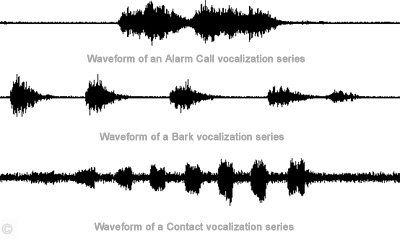 Chinchilla Vocal Sounds
Chinchilla Vocal Sounds
When you first get a chinchilla, if you haven't studied or learned much about them, you may be surprised when they start making a variety of different vocal sounds.
Although they are generally quiet animals, chinchillas have the ability to make an assortment of vocal sounds in varying volume, tone and melody depending on what they are trying to say and how they are feeling at a specific time.
Chinchillas communicate through body language, olfactory signals and vocalizations. During vocal communication a chinchilla may make attention-seeking chirping calls to signal location information or a comfortable and playful mood. A chinchilla may feel threatened and emit a high pitched alarm call as well as shed fur (known as Fur Slip), they may let out a warning call or sound like they have hiccups. All these vocal interactions are marked by distinctive behaviors, communicative attempts and the volume of the sound will be directly impacted by the size and personality of the individual chinchilla.
Chinchillas are all unique (just like us humans) and have a different vocal sound that you will be able to tell apart from other chinchillas over time and with practice. The best way to identify your chinchilla's unique vocal sound is to spend time with them and get to know its personality and mannerisms.
You may notice a chinchilla which, usually makes a lot of sound, goes quiet or you may have a chinchilla that usually doesn't make much sound, suddenly become more vocal. Both these circumstances mean a chinchilla is trying to tell you something and it is only if you are familiar with the chinchilla's individual sound that you will have a better chance of understanding your chinchilla and what he/she's trying to say.
A identified 7 major call types - 4 associated with 'Offensive/Defensive Behavior' and 3 associated with 'Investigative/Exploratory Behavior'.
The vocal study also identified a further 5 categories of different behaviors these being: Enemy Avoidance, Agonistic, Contact, Exploratory and Sexual Interaction. Within these 5 categories 10 different call types were identified. We shall look at 4 of them:
Exploratory/Positional Vocal Sound - Exists in a behavioral category of its own. The production of this vocal noise is a low frequency, gentle and chirpy sound. It is commonly used from birth to signal others of its presence and is also a sign of comfortableness. The professional name for the communication contact between mother and kits is known as 'Supplication'.
Contact Call - Resembles a rapid series of gentle grunts and belongs within the Contact Behavior category. It signals a playful, comfortable and inquisitive mood. The contact call usually co-exists with the Exploratory Call during chinchilla interactions and is acquired from birth. The Contact Call occurs in a lower frequency range (-600 Hz) than the Exploratory Call (+600 Hz) and is a highly complex vocal production - an abrupt onset followed by a downward sweep. A chinchilla kit will respond to a contact call from birth.
Bark Call - The 'Bark Call' is just as it implies - a harsh, high intensity, noisy call. The vocal sound is typically characterized by a rapid intensity onset with a less abrupt tapering-off. The Bark Call is a repeated sequence of 3-5 rhythmic vocal sounds with the first bark being the most intense. The Intensity of the call declines at the offset, which is then followed by a short quiet interval before continuation of the sequence begins again. The Bark Call falls under Offensive/Defensive behavior and into the Enemy Avoidance category. If a chinchilla feels threatened, they will emit a series of loud Bark Calls to warn others. In a study of 26 chinchillas, the bark call was heard when chinchillas were fighting. All other chinchillas responded to this vocal sound by hiding and attentively waiting before re-checking the situation after a few minutes. Chinchilla kits responded to the Bark Call from 13 days of age.
Alarm Call - Resembles an ear-piercing squeal or shriek. The extreme intensity of the Alarm Call is maintained throughout the sequence of calls, which can be anything up to 20 high pitched sounds. The Alarm Call signals that the chinchilla is in pain or fear. A short Alarm Call is a shorter sequence of vocal tones and is an interpretation that a chinchilla is excited or agitated about something unfamiliar. It is like a warning sound to other chinchillas and was used in the wild by the 'look-out' chinchilla if any predators or harm was approaching. Other chinchillas, when hearing the vocal sound of the Alarm Call, are observed to leap around the cage and try to hide. A chinchilla kit will respond to an Alarm Call within 10 days from birth. The Alarm Call falls under Offensive/Defensive behavior and into the Enemy Avoidance category. In an observation of 26 chinchillas, the production of the Alarm Call was observed in fighting females, biting adult males and directed towards a nearby male kit just after birth. During the sound of the Alarm Call the offending chinchillas were stood on their hind legs with their body and head raised, leaning slightly forward with their mouth open and exposing teeth. The chinchilla's tail was puffed whist the ears and whiskers were back.
A chinchilla's vocal sound (or voice) and its posture can tell you a lot about how a chinchilla is feeling. It is important to try and understand what your chinchilla is saying as this is usually a reflection on how they feel and will be imperative towards a chinchilla's on-going health and well-being.
As you spend time with your chinchilla every day, especially when you let them out of the cage and roam around you, you will get to know them better and learn what their individual vocal sounds mean. This will help you understand if your chinchilla needs something or is just being friendly and happy to see you.
Chinchilla Posture & Behavior
 A chinchilla's behavior is an indicator of its mood, attitude and intention.
A chinchilla's behavior is an indicator of its mood, attitude and intention.
Chinchillas are inquisitive but cautious and will eagerly investigate new objects or environments. They possess a variety of play behaviors such as jumps, head shaking, hopping, bucking, running, and body twisting, which is fun to observe and means they have shed their inhibitions and are showing you they are happy and secure in your company.
Aggressive behavior only occurs between non-compatible animals or if the chinchilla is being ill-treated. A frightened chinchilla will run away as fast as it can and may bite if there is no escape. In such situations a chinchilla may spray urine and produce loud shrill cries in self-defense. In a familiar, safe environment a chinchilla will rest with eyes open stretched out or sitting comfortably.
Below is just a few or the different variety of postures and chinchilla can acquire together with their potential vocalization sound.
 Standing Very Straight and Still - This chinchilla posture indicates that a chinchilla has sensed something unfamiliar either a smell or noise and will soon run off. A chinchilla will jump back in its cage and hide, re-emerging after a minute. There may be a short Alarm Call associated with this posture.
Standing Very Straight and Still - This chinchilla posture indicates that a chinchilla has sensed something unfamiliar either a smell or noise and will soon run off. A chinchilla will jump back in its cage and hide, re-emerging after a minute. There may be a short Alarm Call associated with this posture.
Withdrawn In The Corner Of The Cage - This posture indicates an underlying illness, anxiety or the chinchilla is extremely frightened. You should eliminate any possibilities of the posture reflecting an illness and perform a mini examination. If the chinchilla is withdrawn in the corner of the cage due to anxiety or being frightened, it is best to talk calmly/reassuringly and not stare the chinchilla directly in the eye. Don't attempt to pick him up or approach the cage. An associated vocal sound may be Teeth Noises or a Hiss Sound.
Listlessness - Lying around not doing much will mean either the chinchilla is taking a quick rest or nap, is bored or feeling ill. Firstly check if the chinchilla has taken a rest because he has just finished exercising or is bored from lack of interactions and items to play with and gnaw-on. Generally listlessness is a serious medical condition as commonly it is a reflection of an underlying illness, which must not be ruled out and further investigation necessary.
Hopping or Jumping Around On All Fours - This is one of the most amusing qualities a chinchilla can show you. They will bounce about on all fours springing into the air. This indicates that they are playing without a 'care in the world' and you should just sit there and enjoy the show. During this time, you will also hear faint chirpy chatter unless they bump into something then you will hear a loud shrill.
Learning the different vocal sounds and postures of your chinchilla will be one of the most exciting adventures you will unfold. An Essential Guide to Owning a Chinchilla is a fantastic book that covers all 10 different vocal sounds and analyses over 10+ body postures (unlocking the secrets of their meanings). It will help you understand your chinchilla quicker and make bonding much easier. Read more...
Further Reading Relating To Chinchilla Vocal Sounds & Postures:
An Essential Guide To Owning A Chinchilla, Chinchilla A-Z Health & Sickness Bible, Chinchilla Health, Illness, Sickenss & Disease, The Chinchilla.



 A chinchilla's behavior is an indicator of its mood, attitude and intention.
A chinchilla's behavior is an indicator of its mood, attitude and intention. Standing Very Straight and Still - This chinchilla posture indicates that a chinchilla has sensed something unfamiliar either a smell or noise and will soon run off. A chinchilla will jump back in its cage and hide, re-emerging after a minute. There may be a short Alarm Call associated with this posture.
Standing Very Straight and Still - This chinchilla posture indicates that a chinchilla has sensed something unfamiliar either a smell or noise and will soon run off. A chinchilla will jump back in its cage and hide, re-emerging after a minute. There may be a short Alarm Call associated with this posture.